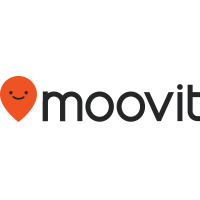
Yovav Meydad Chief Growth Officer Moovit
1. What transformation have you seen in the urban mobility data marketplace in the past 12 months and do you expect further change?
We believe that data is the fuel of mobility and will be the operating system – the brains and heart – of smart cities, and we are happy to see much more interest from transport agencies, municipalities, and private companies to harness the power of Big Data as an important tool to make their urban mobility decisions.
We’ve also seen more interest in our On-Demand solutions that incorporate Big Data analytics in the planning phase to determine where vehicles should be deployed, which can make the difference between a successful and failed On-Demand project. Since transport agencies have been struggling to quickly readjust fixed lines and with having their vehicles not in use because of COVID-19, we’ve seen the demand for these smart mobility solutions increase exponentially. Based on the increased interest, we can deduce that there are more providers turning to data-based Mobility as a Service solutions.
2. How do you anticipate ridership will evolve in response to COVID-19?
It’s no secret that the crisis had a direct impact on transport systems & ridership all around the world. COVID-19 created a new reality for cities and operators, reducing 40-90% of their ridership, as we saw first hand and documented in our report about the impact of COVID-19 on public transport. We recently surveyed commuters in several European cities how they plan to travel around in the next six months to get some insights on what ridership looks like in the near future.
70% of Parisians said that they would be using public transport, not too different from 80% of Lisbon locals that said the same, compared to 49% of Italians.
When Parisians were asked what would encourage them to use public transport more, 43% said real-time arrivals to avoid having to wait at crowded stops, while 31% said pre-booking journeys with a limited number of rides would make them feel more comfortable. In Spain, the top answer was ‘disinfection and cleaning of vehicles more often’. So, we can anticipate that riders in different countries will have different needs when it comes to using transport, with an emphasis on maintaining social distancing, and having the ability to pay digitally using mobile devices.
3. How do you see city/MSP (mobility service providers) relationship evolving across Europe?
The relationship between cities and mobility service providers is moving in a positive direction and there is much collaboration in the works. In Europe, we especially see this in France. Just a few months ago the French Mobility Orientation Law was passed which is set to transform the mobility sector, and positively impact many mobility service providers. The law encourages greener forms of mobility, including shared micro-mobility options, along with integration between these newer players and the traditional forms of public transport. New buses will be required to be able to carry at least five bikes, and train stations will need to provide safe bike parking infrastructure, for instance. France is just one example, but many European cities are turning towards mobility service providers as a means to encourage more accessible, efficient, and greener cities.
4. What do you currently see as being the main obstacle to creating seamless sustainable intermodal mobility?
The industry has made great strides in simplifying multimodal journey planning, but there is still work to be done: exposing multimodal information to people that may not know these options exist, and making the plan, pay, and ride process completely frictionless.
People living in the suburbs often rely on their private vehicles as part of their first and last-mile segment to connect with the main nearby transport hub. They drive their private cars to the station, park it there, and then hop on the bus or rail service. For those living in the city, many avoid public transport altogether and take taxis instead. What everyone in both scenarios have in common are many alternative and convenient options that they may not know exist. By being able to better inform and connect people with micro-mobility options and ride-sharing, more will be encouraged to use them and depend less on their private vehicles.
The second obstacle is integrating mobile ticketing and payments for a seamless plan, pay and ride experience. Currently, the journey planning and payment process of public transport is a largely disjointed hassle. Right now, many people use one app to unlock a shared-scooter, open a second app to find the best route to the Underground, enter the station, try to figure out how much the fare will cost depending on the hour of the day, then search their pockets for change to top up their Oyster card. All while trying not to miss the Tube. That’s anxiety-inducing.
Having the ability to plan and pay for your multimodal journey is a game-changer: A hassle-free, simple user experience that would shift more people from using their private cars to alternative forms of transport. There needs to be more micro-mobility providers, transport agencies, and cities that will support mobile payments for riders to enable them to plan, pay, and ride through a single app.
5. What predictions might be for the mobility landscape in Europe over the next 12 months?
Some predictions, based on interest that we have received, include more data-based On-Demand solutions to support commuters in the first/last-leg of their journey. We’ll also see more agencies leveraging Big Data and mobility analytics to better optimize and adapt their services as lockdowns end. We also predict more mobile ticketing and payment integrations, which will also enable people to pre-book seats on transport to help with crowdedness levels, and contactless payment solutions which is important in a post-COVID world.
6. Tell us more about the Intel acquisition. Have your goals changed and are there any new and exciting developments we should expect in the future?
Simplifying urban mobility has been Moovit’s goal from day one. This hasn’t changed, and will never change. Both Moovit and Mobileye share a vision to change the world of mobility by allowing everyone to travel with confidence in the most efficient way. Urban mobility is the lifeline to employment, education, social life, and everything in between. When all parties of cities are connected and accessible, endless opportunities are created.
Together, Moovit and Mobileye will benefit citizens and cities, and accelerate our joint plans to bring MaaS to every city and citizen around the world. The combination of Moovit’s userbase, our deep understanding of people’s mobility usage patterns and needs (mobility intelligence), together with Mobileye’s world-leading self-driving vehicle technology, will create revolutionary transportation alternatives - fleets of shared autonomous vehicles and robotaxis.
This essentially means that people and our partners will have access to a wider range of mobility alternatives to choose from, including multi-modal journeys that combine public transport, bikes, scooters, shared-cars, ride-hailing, and Mobileye’s fleets of self-driving robotaxis. We will also offer cities better urban mobility insights to help them better understand their citizens’ mobility needs, and match them, in real-time, with the best mobility options.
The combination of our companies, teams, and products will position Intel at the forefront of the mobility world and will greatly accelerate the ability to simplify urban mobility and make getting around more efficient.




































